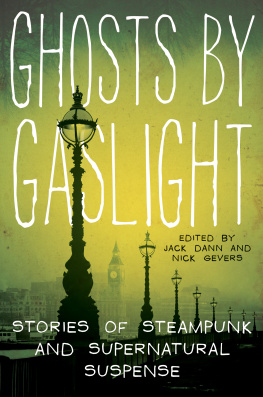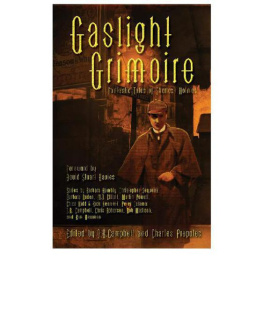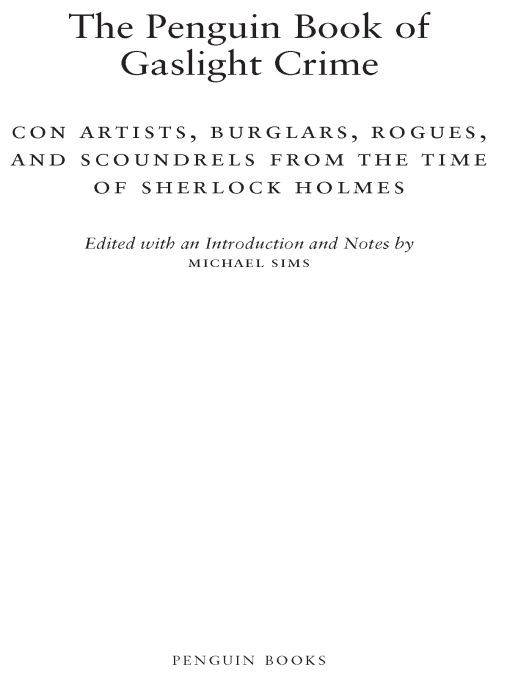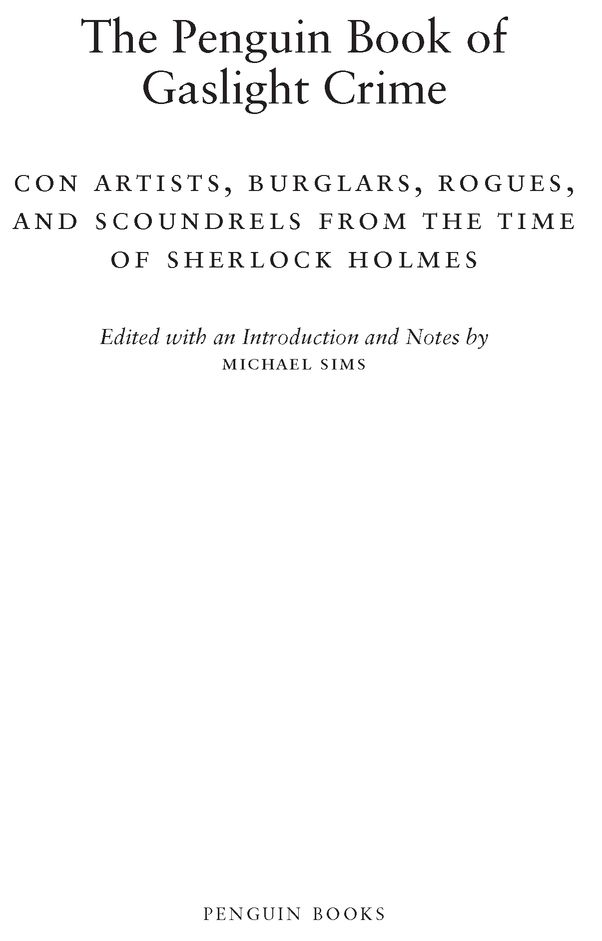Table of Contents
penguin

CLASSICS
THE PENGUIN BOOK OF GASLIGHT CRIME
MICHAEL SIMS has edited two other collections for Penguin Classics: The Annotated Archy and Mehitabel and Arsne Lupin, Gentleman-Thief. His research for the latter inspired The Penguin Book of Gaslight Crime. His most recent nonfiction book is Apollos Fire: A Journey through the Extraordinary Wonders of an Ordinary Day, which National Public Radio chose as one of the Best Science Books of 2007. He is also the author of Adams Navel: A Natural and Cultural History of the Human Form, which was a New York Times Notable Book and a Library Journal Best Science Book; and Darwins Orchestra: An Almanac of Nature in History and the Arts. His writing has appeared in New Statesman, Gourmet, Orion, the Washington Post, and many other periodicals in the United States and abroad. Learn more at www.michaelsimsbooks.com.
Acknowledgments
First I want to thank the anthologists and scholars who helped lure me into this entertaining subset of crime fiction, primarily Ellery Queen and Otto Penzler. Throughout my work on this collection, Otto advised and encouraged. I also especially want to thank anthologist Douglas G. Greene; Roger Johnson, BSI, editor of The Sherlock Holmes Journal in England; Steven Womack, detective novelist and always the best man; and Larry Woods, longtime friend, encyclopedia of mystery fiction, and co-owner (with the charming Saralee) of BookMan/BookWoman in Nashville, where I first discovered some of these authors and characters. For other help, including comments on the text or the story lineup, my thanks to Alan Bostick, Maria Browning, Michael Dirda, Jon Erickson, Casey Gill, Karissa Kilgore, Jane Langton, Michele Slung, and Art Taylor. Thanks to Cesare Muccari and his excellent staff at the Greensburg Hempfield Area Library, especially those indefatigable book detectives, Cindy Dull and Linda Matey. As always, the enterprising crew at Penguin has been superb. My thanks to executive editor Elda Rotor, editorial assistant Lauren Fanelli, publicity director Maureen Donnelly, production editor Jennifer Tait, copy editor Randee Marullo, and publicist Courtney Allison (not to be confused with the private eye). And perpetual gratitude to my wife, Laura Sloan Patterson, the actual trained scholar in the family, who continues to encourage and assist my forays into dusty corners of literary history.
Introduction
Fools and Their Money
A fool and his money are soon parted, wrote Thomas Tusser, the sixteenth-century Englishman who also made the astute observation that Christmas comes but once a year. As history and the daily news demonstrate, there are as many species of thieves in the world as there are of foolishness. Not surprisingly, one is often drawn to the other. The book you hold in your hand is populated with clever thieves who make their living by separating fools from their money as efficiently and as often as possible.
When I first became interested in crime fictions little sub-genre of caper stories, I went looking for an anthology about these charming miscreants. To my surprise, I searched in vain. No such volume existed. Although the important detectives of the era had been herded into a lineup again and again, the great con artists and burglars had mostly eluded capture. So eventually I suggested to Penguin that together we remedy this oversight. In the present volume, for the first time, the best crooks of the gaslight era are gathered in one place.
Our party includes distinguished guests from outside the field of mystery and detection. Who but the dustiest of scholars remembers that American Nobel Prize winner Sinclair Lewis and British novelist Arnold Bennett wrote an occasional crime story? Most collections of short fiction by O. Henry omit his crime stories, other than the sentimental account of safecracker Jimmy Valentine, and thereby miss the adventures of his itinerant con men in small-town America. William Hope Hodgson, renowned for his supernatural fiction, also wrote a volume of stories about a wily smuggler.
Fans of Victorian and Edwardian detective stories may find their favorite authors working here on the other side of the law. Some of the great thieves of this era were chronicled by people known for their popular crime fighters. For example, the prolific Edgar Wallace, nowadays remembered mostly for his detective J. G. Reeder, provides one of the adventures of a con woman nicknamed Four Square Jane. And of course the legendary thieves are hereA. J. Raffles, Colonel Clay, Simon Carne, Get-Rich-Quick Wallingford, the Infallible Godahl. I omit the suave Arsne Lupin because I have already devoted an entire volume to his adventures: Arsne Lupin, Gentleman-Thief (Penguin Books, 2007). I have included a single quirky detective story, the first adventure of Robert Barrs Frenchman Eugene Valmont, because all the action in it is masterminded by an offstage thief.
This volume gathers stories about the thieves of the gaslight era, so I ought to define both gaslight and thief. The taxonomy of genre fiction is no more precise than that of the larger world of literature. Such terms as gaslight, noir, and hard-boiledlike modernist or surrealare labels applied after the fact and for diverse reasons. One writer may employ gaslight era to represent the heyday of Arthur Conan Doyle and the next writer may use it to approximate Queen Victorias entire reign from 1837 to 1901. Technically, the real-life period of gas lighting began in 1807, when Londons Pall Mall first lit up like a fairy-tale kingdom. Edison invented the incandescent bulbthe filament lamp that replaced gas lightingin 1879, but probably no city finished replacing all its gas lamps until after World War I. Some places (London, Berlin, even Cincinnati) still employ gaslight streetlamps in certain historical neighborhoods.
Therefore I felt comfortable using the term to cover stories that appeared between the mid-1890s and the early 1920spretty much the era of Sherlock Holmes. For me gaslight invokes a mood and a voice, both of them romantically luminous with distilled scenes from Robert Louis Stevenson, Charles Dickens, and Arthur Conan Doyle. The term implies an urban setting, minus the honking stench of our modern highways; sophisticated characters, but not twenty-first-century cynics. The moment I envision a gaslight lamp, the special-effects department in my brain surrounds it with London fog. Then it cues the rattle of a hansom cab across cobblestones and the whinny of a horseeven though several stories in this volume occur elsewhere in Europe or in the United States, and the later adventures include telephones and motorcars.
In these pages our own daily world fades away: no television, no jet planes, no computers. Escapism? Of course. Can it be that we are nostalgic for an era that none of us experienced? After all, Nostalgia, says the Chilean novelist Alberto Fuguet, has nothing to do with memory. From our perspective we know what awaits these characters around the curve in the twentieth century: airborne bombing, genocide, poison gas, nuclear weapons. The gaslight era is close enough to seem familiar and far enough away to feel safe. Furthermore, the authors wrote with enviable freedom from technical research. Stories from that era, observes the crime-fiction collector Larry Woods, legitimately avoid the mystery/detective structural problems of technology, since almost all the forensic technology known to the modern reader was then in its infancy or had not yet achieved wide practical application. Perhaps it is no coincidence that, in the (fictional) heyday of criminal masterminds, the pinnacle of crime-fighting technology was Sherlock Holmess magnifying glass.








 CLASSICS
CLASSICS